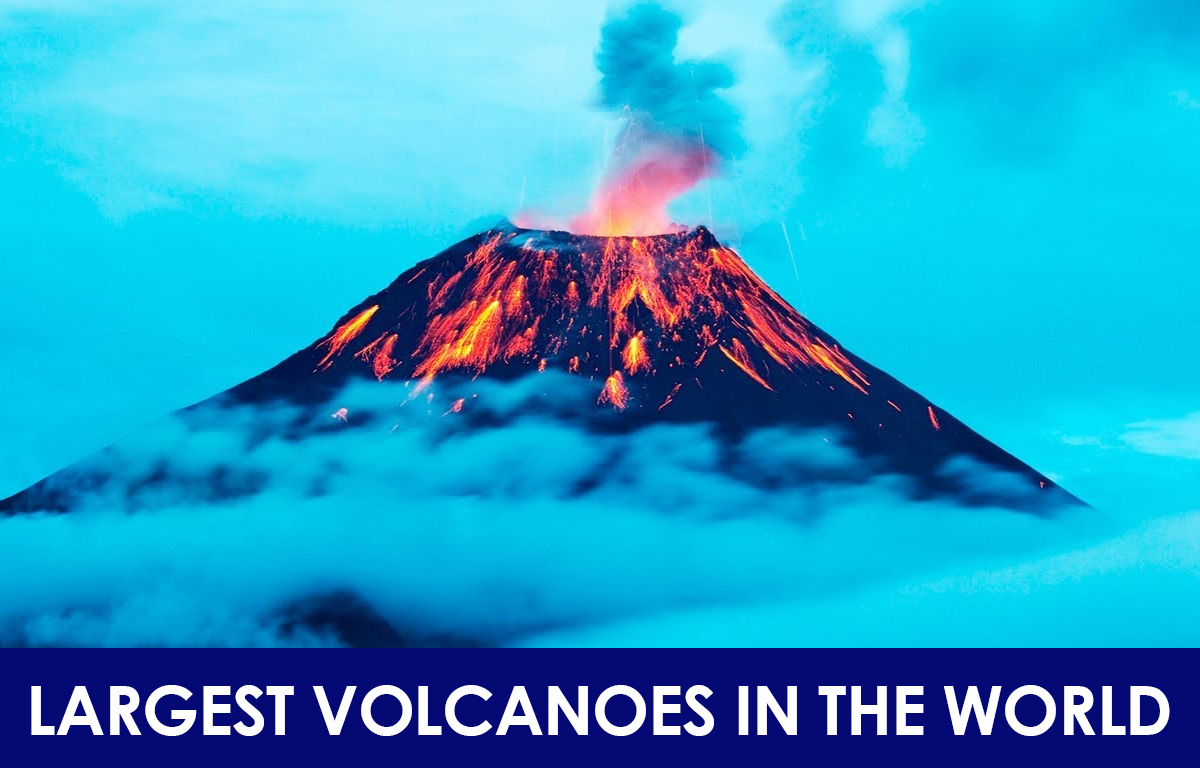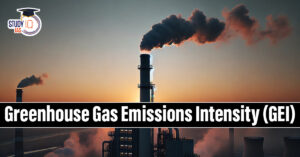Table of Contents
Volcanoes, with their awe-inspiring presence and potential for dramatic eruptions, are pivotal features in the study of geography and earth sciences. Understanding the largest volcanoes in the world is essential for UPSC aspirants, as it enhances their general awareness and provides insight into the dynamic processes shaping our planet. Check Out the Largest Volcanoes in the World List in this article.
What Are Volcanoes?
Volcanoes are geological formations where magma (molten rock) from beneath the Earth’s crust erupts through the surface, creating mountains, craters, and other volcanic features. They are formed by tectonic plate movements and are classified as active, dormant, or extinct based on their eruption history.
| Type of Volcano | Description | Example |
|---|---|---|
| Shield Volcanoes | Broad, gently sloping; formed by low-viscosity basaltic lava that can flow over great distances. | Mauna Loa, Hawaii |
| Stratovolcanoes | Tall, steep-sided; built up by layers of hardened lava, tephra, pumice, and volcanic ash; explosive eruptions. | Mount Fuji, Japan; Mount Vesuvius, Italy |
| Cinder Cone Volcanoes | Small, steep-sided; formed from tephra, volcanic ash, and pyroclastic fragments ejected from a single vent. | Parícutin, Mexico |
| Lava Domes | Formed by slow eruption of highly viscous lava that piles up near the vent; can produce violent eruptions. | Mount St. Helens, USA |
| Calderas | Large, basin-like depressions formed when a volcano erupts and collapses into the emptied magma chamber below. | Yellowstone Caldera, USA |
Largest Active Volcanoes in the World
Here is the List of the Largest Active Volcanoes in the World given below:
| Name | Location | Description |
| Mauna Loa | Hawaii, USA | The largest active volcano on Earth, Mauna Loa is a shield volcano that rises about 4,170 meters above sea level and has a volume of around 75,000 cubic kilometres.
It is located on the Big Island of Hawaii and last erupted in 1984. Its frequent eruptions and gentle slopes make it an important location for studying the formation and behaviour of shield volcanoes. |
| Mount Etna | Sicily, Italy | The largest active volcano in Europe, Mount Etna is a stratovolcano that rises about 3,329 meters above sea level and has a volume of around 500 cubic kilometers. It is located on the east coast of Sicily and has been erupting continuously for thousands of years.
Its eruptions are often explosive and produce lava flows, ash plumes, and other hazards that can pose a threat to nearby communities. |
| Piton de la Fournaise | Reunion Island, Indian Ocean | Piton de la Fournaise is a shield volcano that rises about 2,632 meters above sea level and has a volume of around 530 cubic kilometres. It is located on the island of Reunion in the Indian Ocean and is one of the most active volcanoes in the world.
Its frequent eruptions are often accompanied by lava flows that can harm nearby communities. |
| Kilauea | Hawaii, USA | One of the world’s most active and most studied volcanoes, Kilauea is a shield volcano that rises about 1,247 meters above sea level and has a volume of around 75 cubic kilometres.
It is located on the Big Island of Hawaii and has erupted continuously since 1983. It’s frequent eruptions and accessible location makes it an important location for studying volcanic processes and hazards. |
| Mount Nyiragongo | Democratic Republic of the Congo | One of the most active and dangerous volcanoes in the world, Mount Nyiragongo is a stratovolcano that rises about 3,470 meters above sea level and has a volume of around 50 cubic kilometers.
It is located in the Democratic Republic of the Congo and is known for its highly fluid lava that can move at speeds of up to 100 km/h. Its eruptions have caused significant damage and loss of life in nearby communities. |
| Mount Shasta | California, USA | A stratovolcano that rises about 4,322 meters above sea level, Mount Shasta is located in Northern California near the border with Oregon. It has a volume of around 350 cubic kilometers and is one of the largest and most active volcanoes in the Cascade Range.
Its most recent eruption occurred around 200 years ago, and it is closely monitored for signs of volcanic activity. |
| Sangay | Ecuador | Located in the Andes Mountains of Ecuador, Sangay is a stratovolcano that rises about 5,230 meters above sea level and has a volume of around 30 cubic kilometers.
It is one of the most active volcanoes in South America, with frequent eruptions that produce lava flows, ash plumes, and lahars. Its remote location and difficult terrain make it a challenging location to study and monitor. |
| Mount Merapi | Java, Indonesia | A stratovolcano that rises about 2,930 meters above sea level, Mount Merapi is located on the island of Java in Indonesia. It has a volume of around 40 cubic kilometers and is one of the most active and dangerous volcanoes in Indonesia.
Its eruptions are often explosive and can produce pyroclastic flows, ash plumes, and lahars that have caused significant damage and loss of life in nearby communities. It is closely monitored by volcanologists and local authorities. |
| Popocatépetl | Mexico | Popocatépetl is a stratovolcano that rises about 5,426 meters above sea level and has a volume of around 225 cubic kilometers. It is located near Mexico City and is one of the most active volcanoes in Mexico.
Its eruptions are often explosive and produce ash plumes and lahars that can harm nearby communities. It is closely monitored by volcanologists and local authorities. |
| Mount Yasur | Vanuatu | Located on the island of Tanna in Vanuatu, Mount Yasur is a stratovolcano that rises about 361 meters above sea level and has a volume of around 0.1 cubic kilometres.
It is one of the most active volcanoes in the South Pacific, with frequent Strombolian eruptions that produce lava fountains and ash plumes. It is a popular tourist destination, but visitors must take care to avoid hazards such as flying debris and toxic gases. |
Mauna Loa
- Location: Hawaii, USA
- Type: Shield Volcano
- Height: 4,169 meters above sea level
- Description: Mauna Loa is the largest volcano in terms of volume and area covered. It extends approximately 5 kilometers below sea level, making its total height over 9 kilometers. It last erupted in 1984 and is closely monitored for future activity.
Mauna Kea
- Location: Hawaii, USA
- Type: Shield Volcano
- Height: 4,207 meters above sea level
- Description: Mauna Kea is the tallest mountain when measured from its base on the ocean floor, rising about 10,203 meters. It is dormant, with its last eruption over 4,500 years ago, but remains geologically active.
Ojos del Salado
- Location: Chile-Argentina Border
- Type: Stratovolcano
- Height: 6,893 meters above sea level
- Description: The highest active volcano in the world, Ojos del Salado’s last known eruption was around 700 AD. It is characterized by a relatively low profile and significant height.
Mount Kilimanjaro
- Location: Tanzania
- Type: Stratovolcano
- Height: 5,895 meters above sea level
- Description: The tallest free-standing mountain globally, Kilimanjaro consists of three cones: Kibo, Mawenzi, and Shira. Kibo, the highest peak, is dormant, with recent activity about 200 years ago.
Mount Elbrus
- Location: Russia
- Type: Stratovolcano
- Height: 5,642 meters above sea level
- Description: The highest peak in Europe, Mount Elbrus is part of the Caucasus Mountains and is heavily glaciated. It is dormant, with its last eruption occurring around AD 50.
Cotopaxi
- Location: Ecuador
- Type: Stratovolcano
- Height: 5,897 meters above sea level
- Description: Known for its symmetrical cone, Cotopaxi is one of the highest active volcanoes and has erupted more than 50 times since 1738, with the last major eruption in 1904.
Mount Fuji
- Location: Japan
- Type: Stratovolcano
- Height: 3,776 meters above sea level
- Description: An iconic symbol of Japan, Mount Fuji is an active volcano with its last eruption in 1707. It is a popular cultural and spiritual symbol.
Mount Vesuvius
- Location: Italy
- Type: Stratovolcano
- Height: 1,281 meters above sea level
- Description: Renowned for the AD 79 eruption that destroyed Pompeii and Herculaneum, Mount Vesuvius is one of the most dangerous volcanoes due to its history of explosive eruptions and proximity to populated areas. Its last eruption was in 1944.
List of Largest Volcanoes in the World
Here is a List of Largest Volcanoes in the World and their Location given below in the table:
| Volcano | Location | Height (Metres) | Height (Feet) |
|---|---|---|---|
| Mauna Loa | Hawaii, U.S.A | 30085 | 9170 |
| Haleakalā | Hawaii, U.S.A | 30000 | 9144 |
| Teide | Canary Islands, Spain | 24606 | 7500 |
| Piton des Neiges | Reunion, France | 23198 | 7071 |
| Ojos del Salado | Argentina/Chile | 6893 | 22615 |
| Llullaillaco | Argentina/Chile | 6739 | 22110 |
| Nevado Sajama | Bolivia | 6542 | 21463 |
| Chimborazo | Ecuador | 6267 | 20561 |
| Cotopaxi | Ecuador | 5897 | 19347 |
| Kilimanjaro | Tanzania | 5895 | 19341 |
| Cayambe | Ecuador | 5790 | 18996 |
| Mount Elbrus | Russia | 5642 | 18510 |
| Pico de Orizaba | Mexico | 5636 | 18491 |
| Mount Damavand | Iran | 5610 | 18406 |
| Popocatépetl | Mexico | 5426 | 17802 |
| Iztaccíhuatl | Mexico | 5230 | 17159 |
| Mount Kenya | Kenya | 5199 | 17057 |
| Mount Ararat | Turkey/Armenia | 5137 | 16854 |
| Mount Kazbek | Georgia | 5047 | 16558 |
| Mount Bona | Alaska | 5005 | 16421 |
| Klyuchevskaya Sopka | Kamchatka Peninsula, Russia | 4750 | 15584 |
| Mount Karisimbi | Rwanda/Democratic Republic of Congo | 4507 | 14787 |
| Mount Rainier | Washington | 4392 | 14409 |
| Mount Giluwe | Papua New Guinea | 4368 | 14331 |
| Volcán Tajumulco | Guatemala | 4220 | 13845 |
| Mauna Kea | Hawaii, United States | 4205 | 13796 |
| Mount Sidley | Antarctica | 4181 | 13717 |
| Mount Cameroon | Cameroon | 4095 | 13435 |
| Mount Aragats | Armenia | 4095 | 13435 |
| Mount Kerinci | Sumatra, Indonesia | 3805 | 12484 |
| Mount Fuji | Chūbu region, Honshū | 3776 | 12388 |
| Mount Rinjani | Lombok, Indonesia | 3726 | 12224 |
| Semeru | Java, Indonesia | 3676 | 12060 |
| Emi Koussi | Chad | 3415 | 11204 |
| Mount Etna | Sicily | 3329 | 10922 |
| Haleakalā | Maui, Hawaii | 3055 | 10023 |
| Mount Agung | Bali, Indonesia | 3031 | 9944 |
| Pico Basilé | Bioko, Equatorial Guinea | 3011 | 9879 |
| Mount Zuqualla | Oromia Region | 2989 | 9806 |
| Mount Apo | Mindanao | 2954 | 9692 |
| Mount Shishaldin | Unimak Island, Alaska | 2857 | 9373 |
| Mount Ruapehu | North Island | 2797 | 9177 |
| Mawson Peak | Heard Island | 2745 | 9006 |
| Pico | Azores | 2351 | 7713 |
| Beerenberg | Jan Mayen, Norway | 2277 | 7470 |
| Taal Volcano | Batangas, Philippines | 311 | 1020 |
| Pali-Aike volcanic field | Argentina–Chile border region | 180 | 591 |
Distribution of Volcanoes in the World
Volcanoes are distributed mainly along tectonic plate boundaries, which are classified into:
- Divergent Boundaries: Where plates move apart, such as the Mid-Atlantic Ridge.
- Convergent Boundaries: Where plates move towards each other, such as the Pacific Ring of Fire.
- Hotspots: Volcanic regions thought to be fed by underlying mantle that is anomalously hot compared to the surrounding mantle. Examples include the Hawaiian Islands and Yellowstone.
Pacific Ring of Fire: This region encircles the Pacific Ocean and is home to approximately 75% of the world’s active and dormant volcanoes. It is characterized by frequent earthquakes and volcanic eruptions.
Mediterranean Belt: Extending through the Mediterranean region, it includes significant volcanoes like Mount Vesuvius and Mount Etna.
Mid-Atlantic Ridge: This underwater mountain range runs down the center of the Atlantic Ocean, featuring numerous active volcanoes.


 Greenhouse Gas Emissions Intensity (GEI)...
Greenhouse Gas Emissions Intensity (GEI)...
 Red-crowned Roofed Turtles: Characterist...
Red-crowned Roofed Turtles: Characterist...
 Padma Awards 2025 Winners List, Check Na...
Padma Awards 2025 Winners List, Check Na...





















